Report

| www . ICEVI - Europe . org Report |
 |
[ Previous: Europe in Motion by Solveig Sjöstedt | Table of Contents | Next: Workshop's Topics by Marianna Buultjens ]
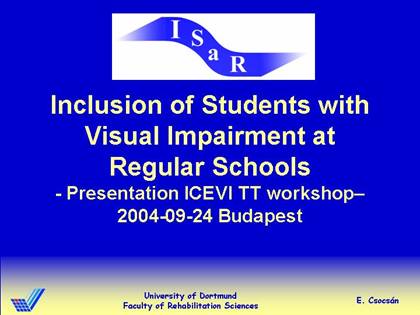
Dear Colleages,
Dear Friends,
It is my pleasure to welcome you to Budapest. I did so once before at the first teacher training workshop of ICEVI in 1997. At that time I was working at the Training College Bárczi Gusztáv in Budapest. After our meeting in March I went to Dortmund in April and began my job at the University of Dortmund. During the years I kept in touch with my colleagues here in Budapest and our common activities within the Erasmus project of the two universities are becoming more and more intensified.
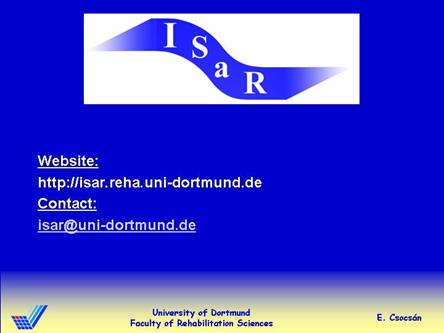
Today I should like to talk about our project ISaR. Because it is a big challenge for me I will share the job with two of my colleagues Frank Laemers and Richard Piatkowski. I will tell you about the philosophy and organisational part of the project, Frank will introduce the different sort of activities and content and Richard, our web-master will talk about the computer basis and technological sides of the project.
I am sure that there are many colleagues among you who remember my report about the young project ISaR in Warsaw. The idea of introducing it on an international level came from Herman Gresnigt, the former European chairman of ICEVI. He visited us in Dortmund many times and followed the development of the project.
Today we will talk about the development of the project from the beginning up to now and tell you our ideas and questions for the future.
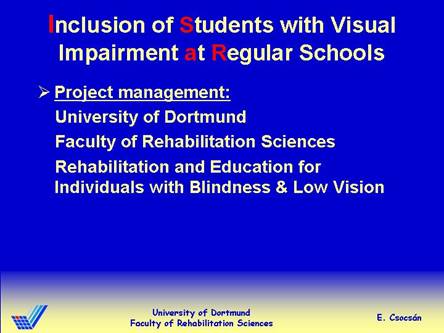
The project started in February 2001 and has been supported by the private Foundation for Education and Promotion for Persons with Disability in Germany. ISaR is a web-based resource centre and supports all involved persons of inclusion of children and young people with VI. The name of the project is an acronym of the words Inclusion of Students with Visual Impairment at Regular Schools.
The project management belongs to the University of Dortmund, Faculty of Rehabilitation Sciences. The University of Dortmund is in North Rhine Westphalia and one of the four universities which offer courses for students in specialisation in teacher training for education of children and young people with VI.

Before I begin to talk about the philosophy of the project I would like to introduce our team. Renate Walthes and I have the responsibility for leading and our young colleagues carried the project on their shoulders and developed it by hard work and excellent ideas. Frank, Juliane, Astrid and Uta belong to the scientific staff, Richard is our webmaster and Marianne is our student assistant.
The Project has an Advisory Board. The members of the board are experts in the field of education of people with VI and they represent the professional policies in Germany. Our present chairman of European ICEVI, Eberhard Fuchs is one of these experts.

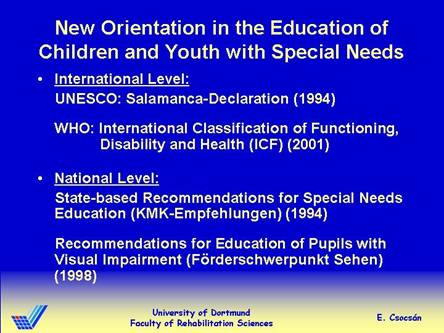
Our professional philosophy is based on the requirements of the documents of UNESCO and WHO and on the national level state-based Recommendations for Special Needs Education (1994) and Recommendations for Education of Pupils with Visual Impairment (1998) in Germany.
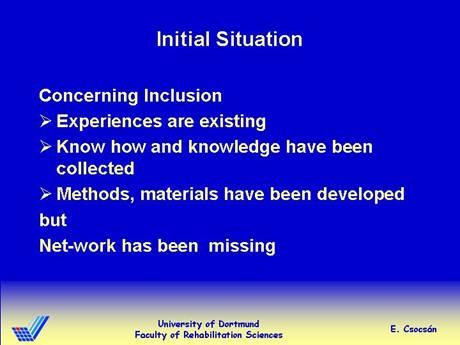
The initial situation was to analyse the situation of inclusion in the field of education of children and pupils with VI in Germany. Much of the experience is more than 30 years old. Counselling and support for children with VI in regular schools and in special schools require special knowledge and raise many questions and produce some problems. On the other side many problems have been solved by teachers, parents and other people involved, many good learning materials have been worked out, methods tested, organisational forms established etc. But in most of the cases the specific knowledge and know-how refer to one particular situation and the knowledge gained, remained in the given school or institution.

The basic idea of ISaR is to use the facilities of World Wide Web and to offer possibilities for teachers and experts but also parents and pupils and students to share their experiences, give and get information and to have the opportunity of cooperating on many levels and in many fields of education of children and youth with VI.
Frank will talk about the databases on literature, on teaching materials and didactic solutions. Now I would like to tell you about our methods of reaching our goal and working out the cooperative network" with teachers and experts.
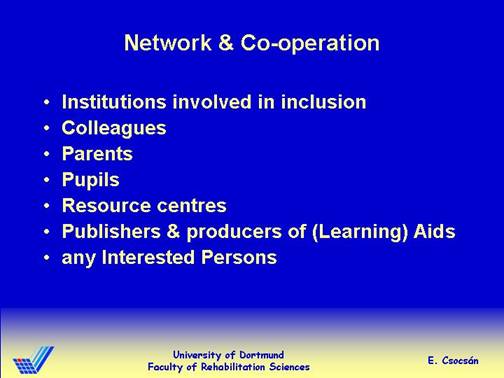
The ISaR is mainly a virtual resource centre but we have many "live" activities, based on our philosophy of enhancing the effectiveness of the project.
The members of the team
ISaR is first of all a professional service for all the participants of inclusion and the members of the team are engaged in a lot of innovative efforts to enlarge the possibilities and to help in quality management on all levels of education of persons with VI.
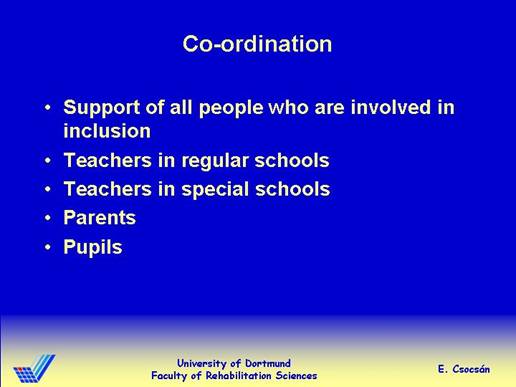
We often meet teachers to help them to co-operate with each other and to share information. We offer them the possibility of preparing good didactical solutions, teaching materials which have been proved in practice in an inclusion situation, to add to our database etc.
We regularly hold courses for teachers. To these meetings we also invite parents and students with VI.
We also involve the students in the project. They develop didactical solutions, learning materials, test and analyse learning environments and situations. Some of their work you can find in the database of pooled teaching materials.
Our main goal is to support inclusion. 30 % of the children and youth with VI attend regular schools in Germany. But there are many children and pupils who learn at special schools. Also one-third of the pupils in other special schools i.e. schools for children with motor dysfunction or schools for children with serious learning difficulties have problems in the field of visual perception. Most of these children do not get appropriate support from the field of education for children and pupils with visual impairment.
One of our next important tasks for the future is to offer more information and help in the field of education for children with MIVI.
At the time of the 3rd workshop on TT in Warsaw the project had just started. It was still a baby.
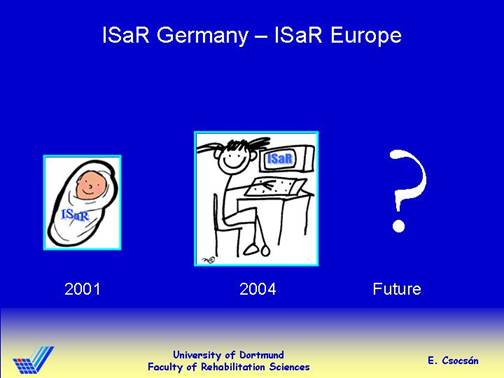
During the years the project has been developed strongly - survived some childhood diseases and now it is a teenager and will be finishing school in Germany. We, the parents, would like to give our child an international future with more facilities and possibilities than we have in Germany. We would like you to think about the possibilities together.
The group 2 of our workshop has the task of collecting all ideas to answer the following questions:
Is it possible to turn the project into a European one?
Is it necessary for the different countries to work out their own ISaR or should we start with the English one?
Which requirements are necessary in your own country to get the project up and running etc?
The whole collection of these questions has been prepared by Frank and Richard and you will get the list after this meeting. I am sure that not only the colleagues in the group 2 will get ideas concerning the turning of ISaR into an European network of experts, professionals and non-professionals, families and above all children and young people with VI. Please give any proposals to Frank Laemers.
The motor of the project is the innovative network. The basic idea is that the key to further development of the education of individuals with visual impairment lies in mutuality and in a network of expertise and resources. What is mutually developed will support and facilitate the individual work.
To carry out the ISaR project we need to co-operate with colleagues, institutions and interested persons in Germany but also at an international level. We are working with the motto of the European Conference of ICEVI in Krakow i.e. Together everybody achieves more and I hope we can follow that motto and profit from the advantages of the European ISaR project together with all the participants of the Inclusion of persons with VI.
Thank you for your attention and can I now please ask Richard to take the floor.
I am very happy to have the opportunity to present to you some of the technical details of the ISaR structure. The first thing that you have to learn as a computer scientist is, that it is not always easy to explain to other people how computers work.
Many people don't understand computers and the underlying techniques. They are ashamed that they don't understand how to use it. They are afraid of making mistakes or destroying something. Nobody is happy using something, which is not familiar to him. In my opinion the user of a computer should never be afraid. It should be vice versa. Computers should be used as an instrument, like coffee machines or a simple pencil.
Using a computer is not always as easy as marketing experts of computer companies' claim that it is. It is still far to complex.
An "easy-to-use" system provides motivation. Motivation leads to good work.
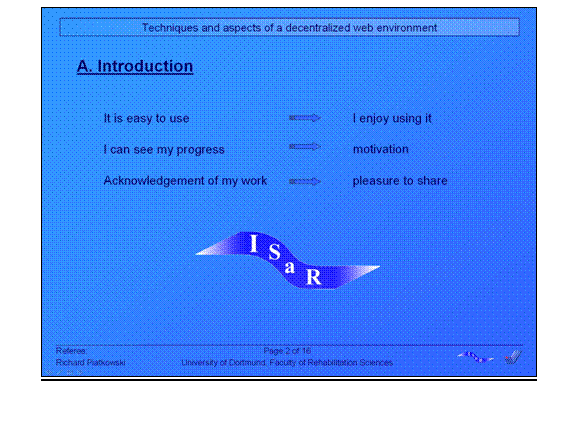
I am telling you this, because it is a good possibility to explain some universal facts. If something is easy to use, people will enjoy using it. If you can directly see the progress of your work, you will be motivated to continue your work. If others acknowledge your work, it will be a pleasure for you to share it. All three principals are achieved by the technical ISaR framework. This introduction leads me to the structure of my presentation, which is divided into three parts and an introduction to databases:
Technically every part of the presentation deals with databases structure and design. Nearly everyone knows the word database, but only few know what a database really is. So I will try to explain it in some simple words.
Structure of the original presentation.
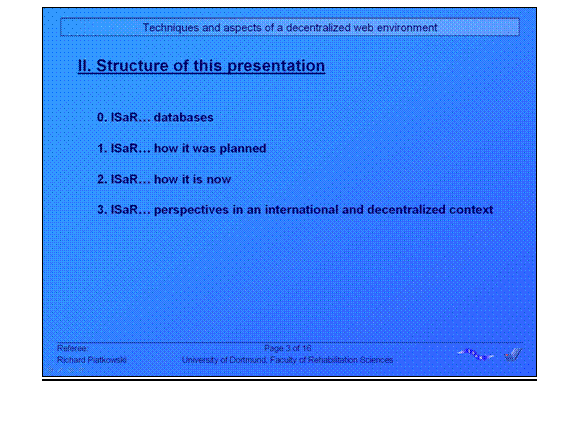
If we take an amount of information and put it in a database and everything goes well, we will have the same amount of information as before, but in a database. The advantage is that now the information hopefully has some structure. If we have a database of authors for example, we will separate the first name from the last name.
Additionally to this, we will enumerate each row with a unique, incrementing number. This number plays a "key-role" in our database design. Let's now have a quick look at the work, which is done by the authors.
Information without structure and in an author database.

We will take some publications and put them also in a database. Then we write down the name of the publication in a column. Every publication has an author. We want to present this information somehow in our publications database. The first idea is to write the authors name in a new column.
Like we did before with the database of authors, we will also enumerate each row in this database with a unique, incrementing number.
Author database and publication database.
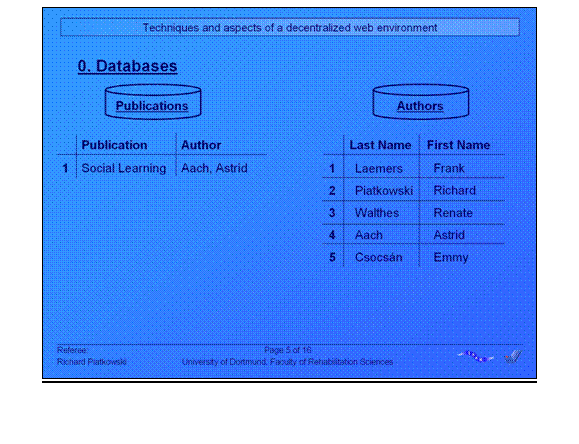
Now we will imagine the following situation. One of the authors gets married and therefore the author's last name changes. The database problem that we have is that the name has to be changed in more than one place. If we have a publications database with thousands of records in it, we have to review every single record to correct the author's name. In the long run, this would be far too much work.
Furthermore we have to find a solution for the situation, that two authors can have exactly the same name. How do we distinguish between the two "name-twins"? How do we know, that we change the right name when one of the two "name-twins" is getting married?
The Information is out of sync.
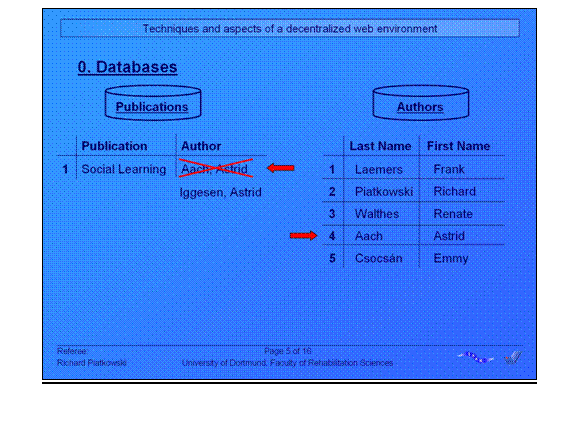
At this point the unique number, the ID, of the database comes into play. We will erase the column 'Author' from the publication database and will add the new column 'A_ID' instead.
From now on we just note the unique number of the author, the author ID, in the publication database in the 'A_ID' field. By this action we create a relation between the two databases.
Still one problem remains. What if one publication has more than one author? We could add more columns to the publication database, like 'A_ID1', 'A_ID2', 'A_ID3'... but this idea is not very good. How shall we know, how many columns we have to add. Are three authors enough? What will we do if one publication has ten authors, while every other publication in our database has only one? We will waste a lot of space and the database will be getting more and more complex.
Relations created by the help of unique IDs.

The solution for this problem is simple and elegant. We simply won't save any of the authors information in the publication database, but we will create a new database that represents all relations between authors and publications.
So we can modify author details and publication details while the relations remain correct. When we change the name of an author, it will be automatically changed in every linked publication.
This is the biggest feature of a relational database system. Every piece of information is saved just one time and linked to other areas by relations. It is the most productive way of working, because information must be typed in only once and can be used multiple times without the need of recreation.
A new 'Relation database' solves the author problem.
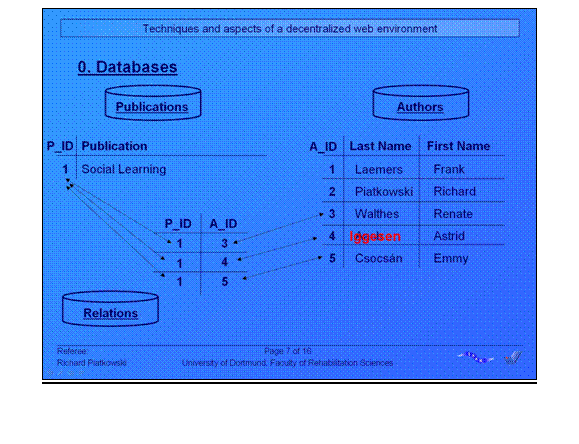
The ISaR structure consists of many databases and many relations. The example I have just shown to you is rather simple. It includes only two databases and one relation.
But what if the system gets more complex? Imagine databases with thousands of literature records and hundreds of authors, a forum with ten thousands of discussion records together with a database of thousands of educational materials with descriptions and user comments.
How is it possible to administrate complex databases like this?
How can big databases be easy to administrate for the user.
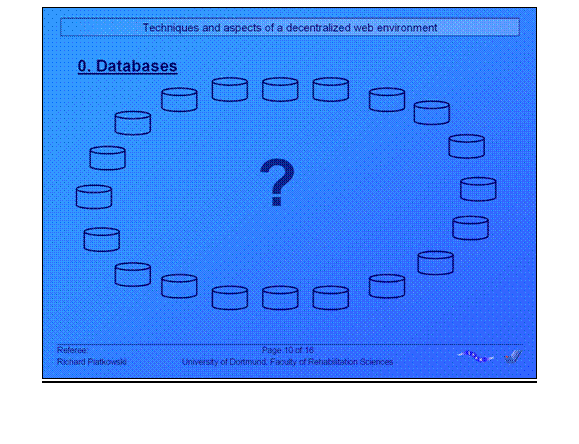
It is possible by building interfaces which communicate between the complex database structure and the user, who only wishes to insert a publication into a literature database for example. This interface is programmed in a way the user can easily understand.
If the user wants to create a publication in the ISaR database, he just clicks on 'create publication' in the administration area, types in the details, selects an author and then simply 'creates' the publication. All administration areas are accessible from the web page. It is as simple as it sounds. Every area of the web page uses the same logic and is directly covered by the sites own full-text-search. Like I mentioned at the beginning, if something is easy to use, people enjoy using it. In the same way it is easily possible, to attach multi media files to database entries, add images to materials or attach keywords to literature entries.
This sounds simple. And it is.
How can big databases be easy to administrate for the user.
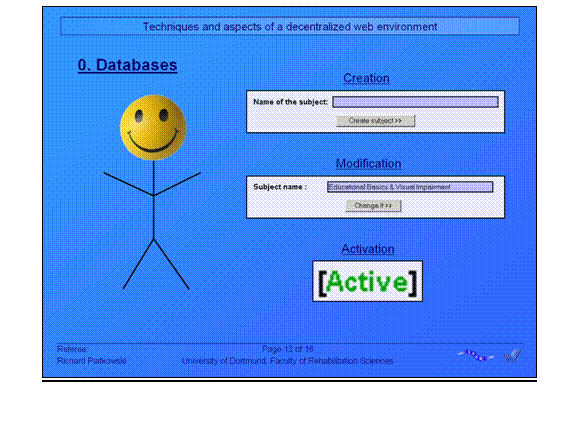
The first database driven version of the ISaR structure started in 2001 and grew quickly. The first dozen database entries became hundreds and soon thousands. So it was necessary to redesign the technical structure.
Initially we had the following areas covered by databases:
Initial structure of ISaR.
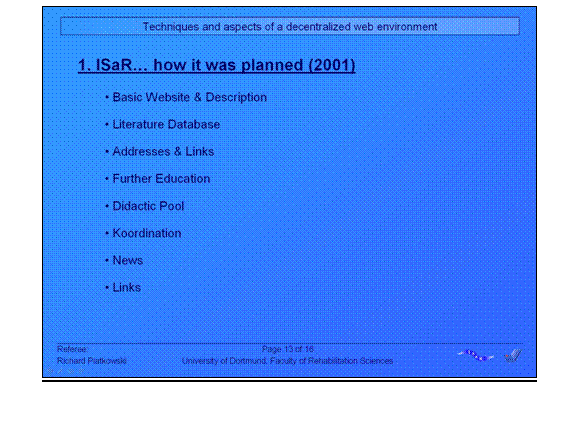
The actual version of the Website features besides its low barrier structure and general information the following database driven areas:
Each point is managed with up to eight databases. We have thousands of database entries in far over ten thousand relations between the different databases to make every bit of information in the ISaR system more valuable for the user.
The actual structure and the next step that has to be done.
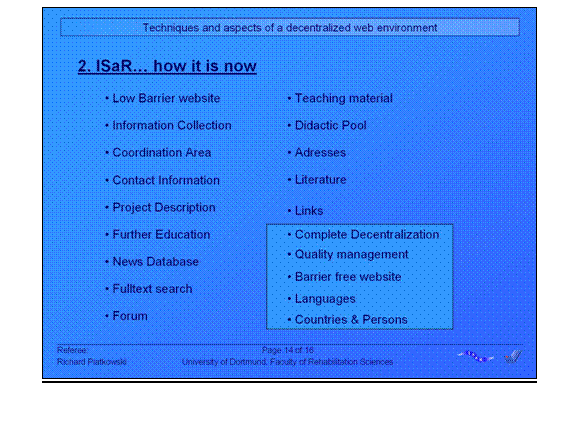
The next possible step would be to integrate the following elements into the structure:
These few new additions will enable the ISaR project to move to a higher level. In my final example I would like to present you with a possibility for ISaR to work in an international and decentralized context.
If the ISaR structure is completely decentralized, it will be able to profit from authors from different countries. Thanks to the structure of the word wide web, all that an author of the ISaR website needs is a computer with web access, so we have a low entry barrier.
Although all authors will be using the same system, national and international content could be easily published using simple web forms. To ensure, that this system produces content on a high standard, quality control methods will be introduced to ensure that every piece of information is published at the same (high) level.
Content will be published automatically in a print and a web, a normal and a barrier free version. It can be automatically downloaded as a PDF file or sent by eMail to interested newsletter recipients all over the world.
It will be possible to create large specialized communities which will use the synergy effects of different countries provided by the new international communication and interaction possibilities. A lot of energy could be saved if ideas would be developed once and continually improved, instead of being redeveloped in parallel at the same time. It is not necessary to reinvent the wheel.
Although this sounds too good to be true, I would like to present to you the example of the 'wikipedia project' where thousands of people from all over the planet have created one of the biggest encyclopedia that is existing today. Over one million quality articles in over 100 languages can be used for free by everyone. Every article is only created once and then continually improved and translated. The 'wikipedia project' can be found at www.wikipedia.org [new window].
This example shows how much potential can be gained, if modern technology is used to support international work following the principle that...
Together everyone achieves more.
I'd like to introduce you to the contents of the website of the IsaR-Project as it currently exists only in German.
We have four main areas of work:
ISaR offers a database of literature on inclusion and VI which can be searched thoroughly. Our intention is to provide a broad collection. Topics include general inclusive education as well as specific issues in visual impairment. All entries come with a short abstract. That way the users can obtain more information on the content of the text. The database can be searched by full-text and keyword search and it currently contains more than 850 entries. Entries of articles and texts that are available online also provide the respective links.
Fig. 1: Screenshot of the Literaturedatabase.
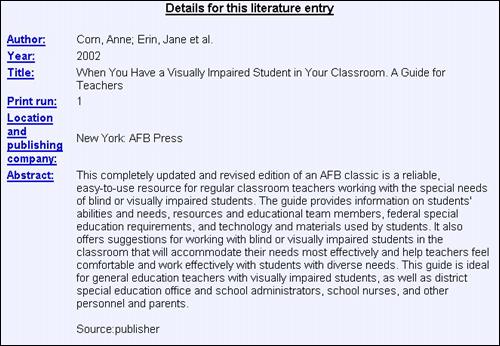
The database of teaching material consists of books, games and other materials that are adapted or suitable to the needs of students with visual impairments or blindness. Apart from materials for the individual school subjects there are also games, children's books and assistive devices. All materials are for sale. We selected them from the range of products of German publishers and vendors of assistive devices.
Non-commercial materials that have been prepared and supplied for exchange by colleagues can be found in the Collection of Instructional Tools.
Currently the database contains 1740 entries.
We intend to:
To achieve these goals we depend on the cooperation of many colleagues, parents and students. We need them to supply their ideas and concepts which they have developed in their practical work on-site. Ideas and self-made materials like these can't be bought anywhere.
Fig. 2: Matrix of the Didactic Pool.
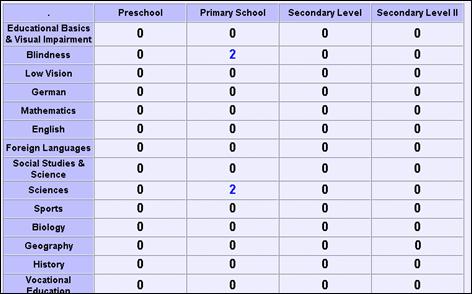
The Collection of Instructional Tools currently contains materials for lessons and games. For easy access we developed a matrix where the materials are ordered by school subjects and by level of education.
We hope for an active exchange on the design of teaching material concerning how the experience and perception of visually impaired as well as that of sighted students are taken into consideration.
We believe that much creative energy is lost because similar materials are developed over and over again in different places. As it is, there are nearly no facilities for passing on the developed strategies to colleagues in different schools or even countries.
The collection of instructional tools currently contains 80 entries.
The following series of pictures will show how students can develop an idea of the den of a mole and the mole itself.
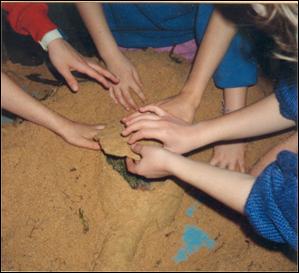
After the molehill has been examined and "grasped" from outside, exploration of the inside starts. Finally the mole itself will be discovered.
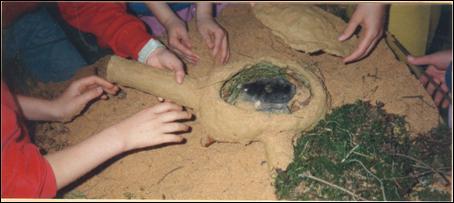
The success of inclusive education depends strongly on the professional abilities of the colleagues involved. For this reason further education is a very important field.
The website features a calendar with dates of further education courses, exhibitions of assistive devices and technology and more events relevant to parents, teachers and students.
We at ISaR also offer further education courses, for instance a course for regular school teachers who teach a student with VI in their classroom or will do so in the future.
Furthermore, we offer further education for school staff on site.
Fig. 3: Calendar with Important Dates and Courses.
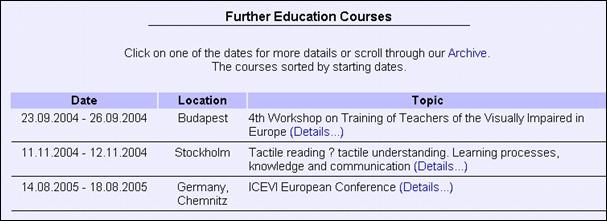
The intention of the coordination office is to support everyone involved in the process of inclusion of students with visual impairments - regular school teachers, special education teachers, parents and students. This support can range from referring clients to local experts to providing specific assistance on subjects and problems in the area of inclusion.
More than half of our clients are parents who seek information on inclusion and its specific problems and issues. The parents appreciate that ISaR offers support independent of any organization (school or resource center).
One of our main fields of work at the moment is the development and maintenance of a network of different organizations involved in inclusive schooling for children and youth.
A multitude of addresses and links can be found here: starting with schools and resource centers for the VI, on to companies selling assistive devices, libraries for audiobooks and braille literature, organizations that offer orientation and mobility training or daily living skills, universities, associations and the broad field of support groups and parent groups.
The item information consists of the following contents:
Fig. 4: Screenshot Adresses.
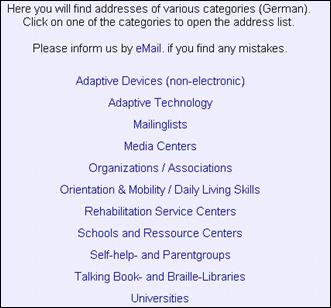
Here we have gathered information on different areas in the field of inclusion and visual impairment. You can find general and basic information on inclusion and VI as well as help with legal issues or personal reports. I'd like to draw your attention to the topic promoting social inclusion.
How can good inclusive teaching be characterized? Usually teaching methods or availability and use of assistive devices are the first to come into mind. The fact that social inclusion is a very important issue - especially for the students themselves - is shown clearly by Marianna Buultjens and Joan Stead in their survey (2002). Chapter 7 of their publication contains the discussion of the results and recommendations. We translated it into German for the ISaR-homepage. The complete publication in English is available online at the website of the Scottish Sensory Centre. (Folie mit Link)
Through a forum exchange of information is possible, questions can be raised and feedback can be voiced. A multitude of topics comes up there, from concrete questions on teaching to legal information and general issues concerning VI in childhood and adolescence.
Our linklist supplies links on the following topics:
I hope that I was able to provide some insight into the multitude of information and contents available on the ISaR-website.
ISaR intends to promote the chances of children and youth with visual impairments for participation in regular education and to help schools develop competence for inclusion.
It became clear that ISaR depends on support from and cooperation with many colleagues at special and regular schools, with parents and students. Only through community, exchange and networking further development and a better quality of inclusive education can be achieved. I am convinced that this is true for Germany as well as for Europe.
Together everyone achieves more.
[ Previous: Europe in Motion by Solveig Sjöstedt | Table of Contents | Next: Workshop's Topics by Marianna Buultjens ]